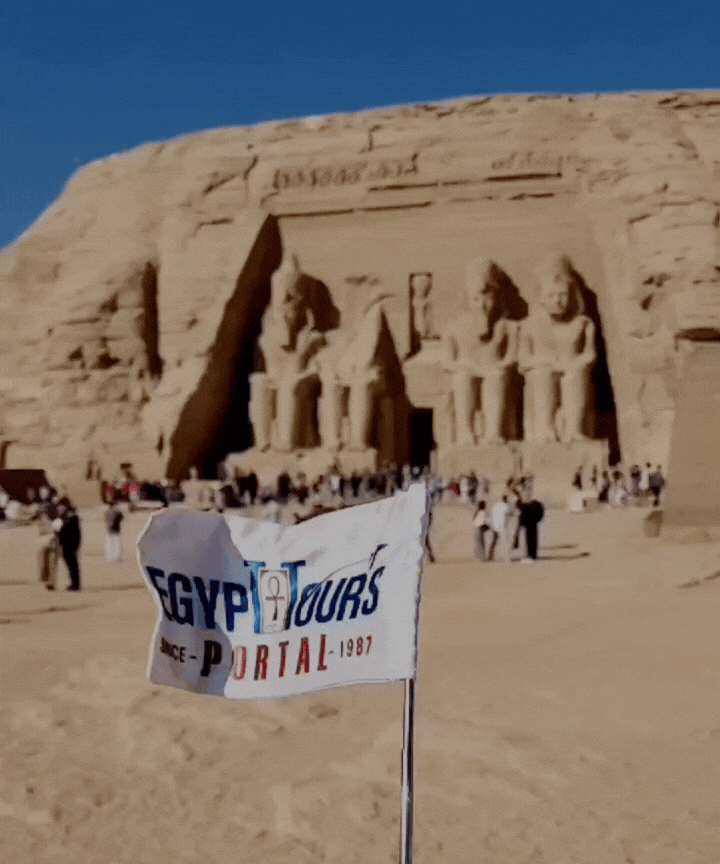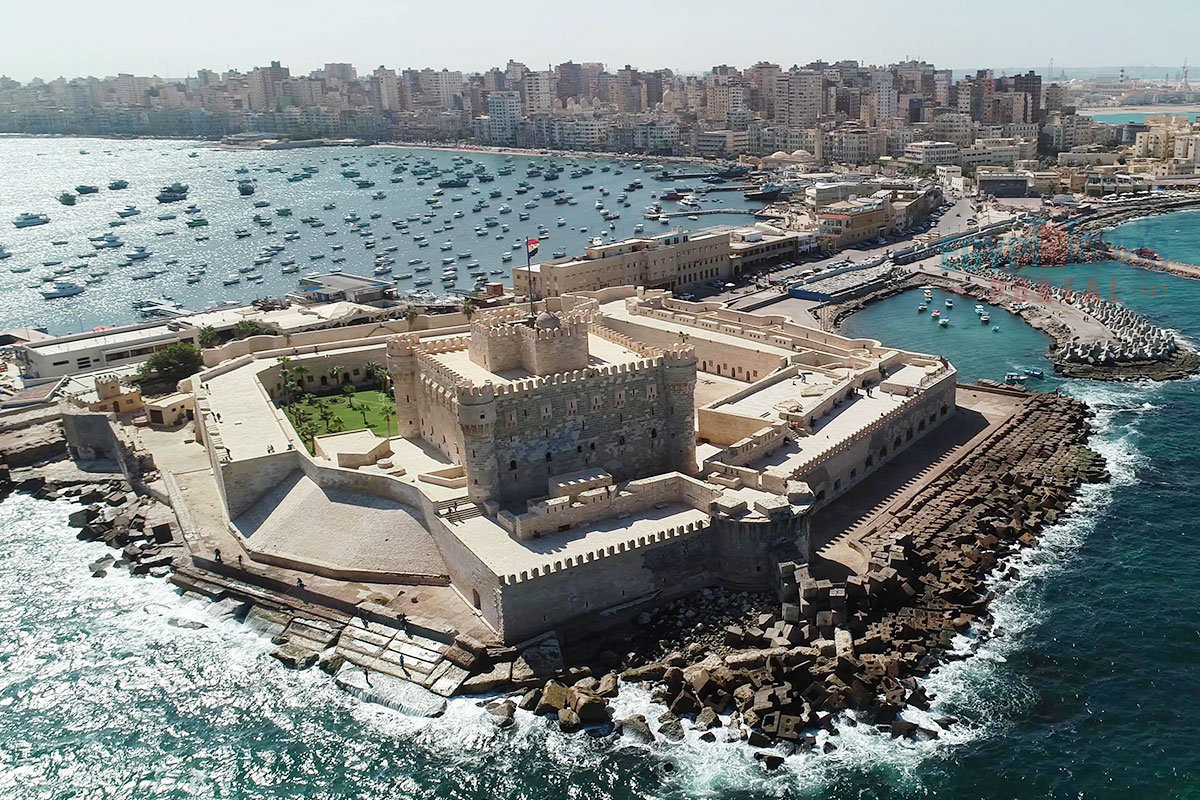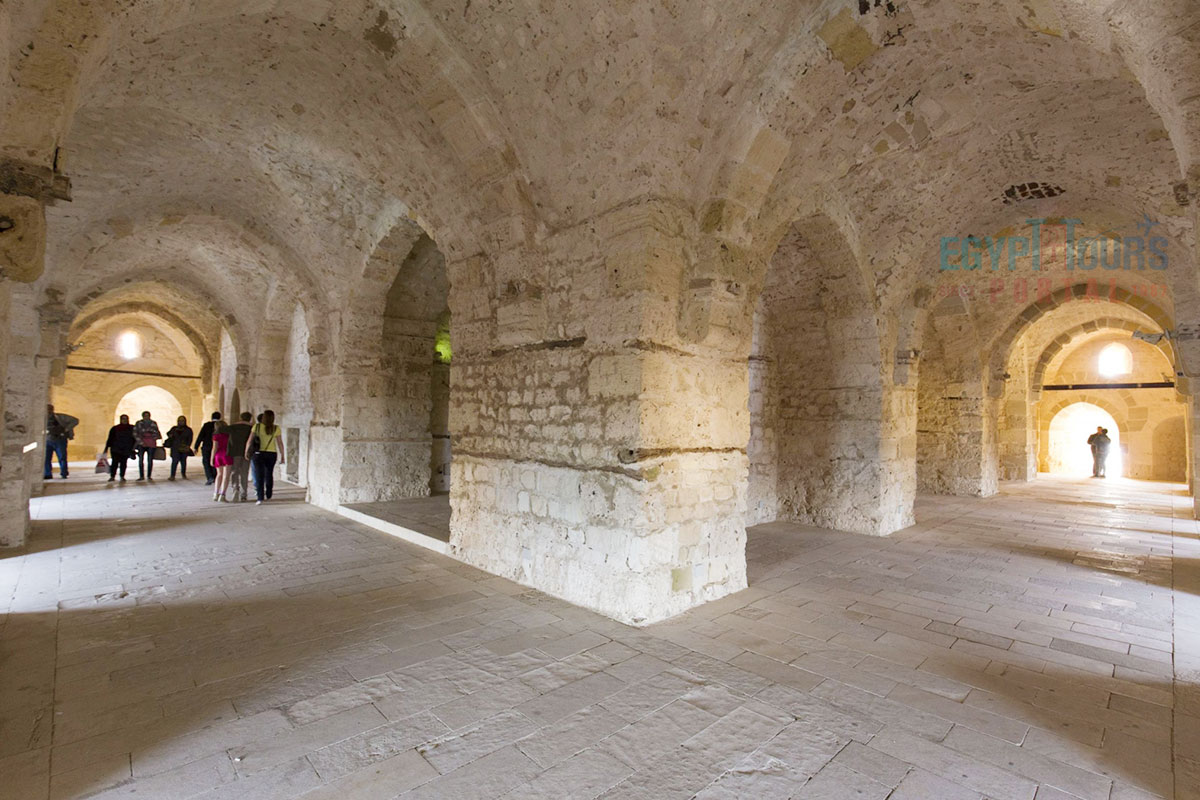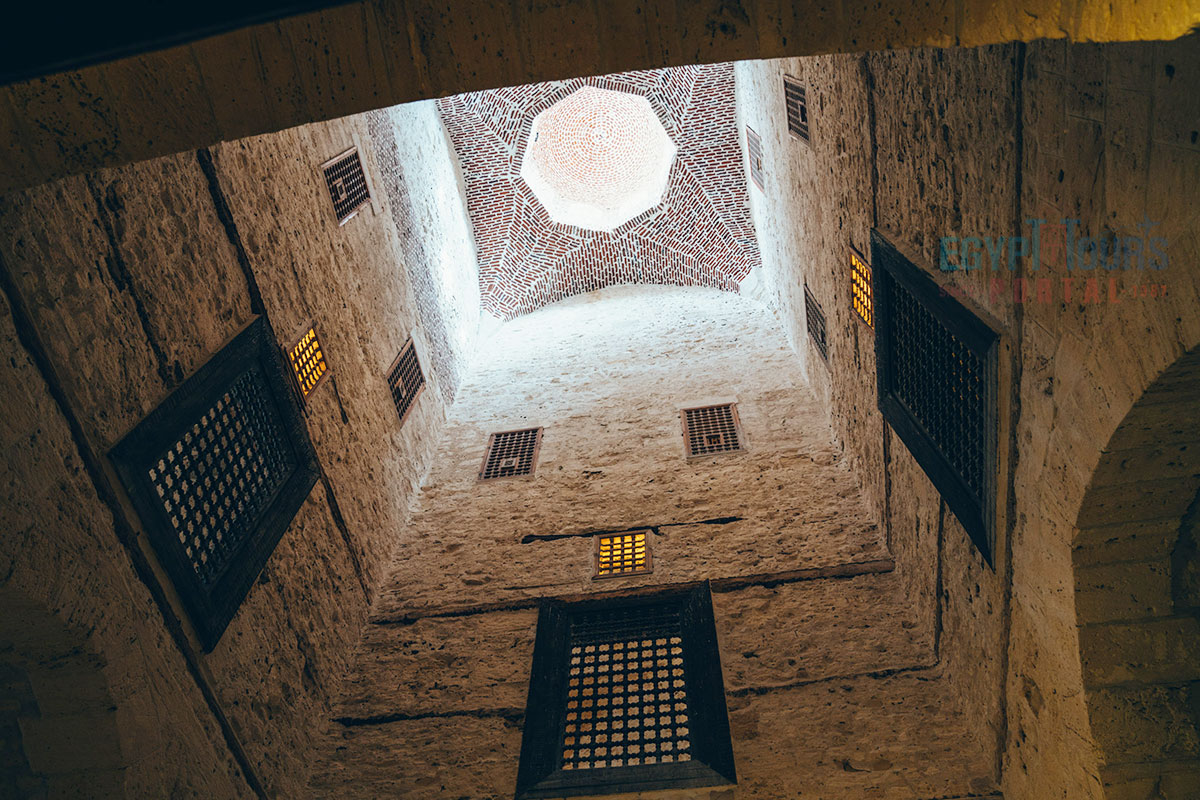The Qaitbay Citadel, built in the 15th century by Sultan Al-Ashraf Qaitbay on the ruins of the ancient Lighthouse of Alexandria, served as a strategic coastal fortress. Designed by Mamluke architect Qagmas Al-Eshaqy using remnants of the lighthouse, it was used by Mamluks, Ottomans, and Napoleon. Despite damage from natural disasters and warfare, it was restored under Muhammad Ali and remains a powerful symbol of Alexandria’s heritage and architectural strength.


The Qaitbey Citadel stands as a timeless guardian of Egypt’s maritime history and cosmic beauty, dating all the way to the 15th century. It was built upon the ruins of the legendary Lighthouse of Alexandria using its own body and soul that once earned the title of one of the Seven Wonders of the Ancient World. This fortress exudes a mystical charm that transports everyone across centuries of Egyptian grandeur and the visions of many different cultures and arts.
With its majestic stone walls kissed by the Mediterranean Sea breeze and its towers offering panoramic views of the endless horizon, the Citadel seems to merge the heavens and the earth. Every corner whispers stories of pharaohs, kings, sultans, warriors, and ancient mariners, making this an unmissable journey into the heart of Egypt’s legendary past.

Qaitbay Citadel is located on the Pharos Island, now part of the mainland, in the district of Bahary, at the western tip of the Corniche in Alexandria. The citadel offers a stunning view of the Mediterranean Sea and Alexandria's harbor, as well as the skyline of the city.
To reach Qaitbay Citadel in Alexandria from the city center (5 km west of Midan Saad Zaghloul), there are a number of options which including the fastest option, which is about 15–20 minutes by local minibus or microbus towards the Corniche, though it involves a 20-minute walk from the nearest station. Everyone will have the option to enjoy a scenic 45-minute walk along the Corniche.
The distance from Cairo is about 220 km away which can take about a 2–3 hour journey from Ramses Station, followed by a taxi or local transport, a 3-hour trip, ending at the Alexandria bus terminal, with a taxi to the citadel, or 2.5–3 hour drive via the Cairo-Alexandria Desert Road or the International Coastal Road.
You can easily forget about this hassle and just book with a travel agency that will arrange all the transfers across all the attractions of Alexandria, including this majestic citadel. Keep in mind that the Citadel is near other prominent attractions, including the Alexandria Corniche, Alexandria National Museum, and the Bibliotheca Alexandrina (Library of Alexandria), which are all worth visiting, so make sure to put them on your dream tour.

One of the Mediterranean Sea coasts' strongest defensive fortresses is the "Qaitbay Citadel", located in the immortal city of Alexandria on the eastern side of the northern tip of Pharos island, and extends out into Alexandria's harbor from the corniche. It was built on the site of the ancient Lighthouse of Alexandria, one of the Seven Wonders of the Ancient World, The Citadel was part of a 15th-century fortification system to protect Egypt.
After earthquakes in the 11th, 13th, and 14th centuries destroyed the lighthouse, the Mamluke Sultan Al-Ashraf Qaitbay built the Citadel in 1480 AD to defend against the Turks. A mosque was also added inside the fortress. It was designed by a Mameluke architect named Qagmas Al-Eshaqy. The work lasted two years, costing over 100,000 gold dinars.
It holds a unique position not only because of played an important role in the fortification system of the city during the 15th century AD, but also because it was constructed on the exact location of one of the seven wonders of the ancient world, "The Lighthouse of Alexandria".
The Quitbay citadel continued to play a vital role during the Ottoman Empire as it was used as a powerful fortress to store and ship weapons from 1517 AD till the next three centuries. During the French campaign in 1798, the citadel caught the eye of Napoleon Bonaparte, so he seized it along with the entire country.
At the beginning of the 19th century, Muhammad Ali worked in renovating the walls of the citadel after it was heavily destroyed by the British naval bombardment and provided the stronghold with modern weapons, which made the reign of Muhammed Ali the golden era of the citadel. The citadel would be restored in the 20th century by Egypt’s Supreme Council of Antiquities.

The Quitbay citadel continued to play a vital role during the Ottoman Empire as it was used as a powerful fortress to store and ship weapons from 1517 AD till the next three centuries. During the French campaign in 1798, the citadel caught the eye of Napoleon Bonaparte, so he seized it along with the entire country. At the beginning of the 19th century, Muhammad Ali worked on renovating the walls of the citadel after it was heavily destroyed by the British naval bombardment and provided the stronghold with modern weapons, which made the reign of Muhammad Ali the golden era of the citadel.

The construction of the Qaitbay Citadel began in 882 AH (1477 AD) when Sultan Qaitbay visited the lighthouse site and ordered the fortress to be built. The Qaitbay Citadel was built using the stones salvaged from the huge lighthouse on an impressive 17,550 square meters that looks very much like a peninsula as it is surrounded by the Mediterranean Sea from three sides.
It has three floors. On the first floor, there is a big mosque, and the second is an octagon containing corridors, halls, and a breathing interior, while the third and final floor is a large circular room holding the seat of the king. Around 884 AH, the Citadel was completed, equipped with soldiers, weapons, and funded through waqfs (endowments). Due to its strategic importance, the Citadel was well-maintained by subsequent Mamluke rulers.

The interior of the Qaitbay Citadel combines practical military features with elements of architectural beauty. It features several key elements, reflecting both its defensive purpose and historical architecture.
Inside the citadel is an inner wall that encloses the citadel’s courtyard, which houses several rooms, some of which served as barracks, while others were used for storage and administrative work. The interior is connected by several narrow passages and staircases, allowing movement between floors and rooms. These features reflect the fortress’s design to be both functional and defensible.
The entrance leads to the central courtyard, dominated by a formidable main tower situated in the northwest corner. This massive, square-shaped fortification rises three floors high, with half-circular towers at each corner, featuring protruding balconies designed for city defense. A nearby tank provided water for the soldiers and their horses. A mosque is located inside the citadel, built as part of Sultan Qaitbay’s vision. It served as a place of worship for the soldiers stationed there.
Sultan Qaitbay is known for his passion for art and architecture, which inspired him to create the position of Edifices Mason to oversee construction projects. He commissioned many structures in Mecca, Medina, and Jerusalem, and in Egypt, he renovated around 70 buildings, including mosques, madrasas, and citadels like those in Alexandria and Rosetta.
Qagmas Al-Eshaqy, who was a Mameluke of Djakmaq, became the Edifices Mason and Viceroy of Alexandria under Qaitbay. Qagmas was also involved in various other architectural projects across Egypt and Syria. He was responsible for the construction of the Citadel on the ruins of the Lighthouse of Alexandria, a project that took two years and cost over 100,000 gold dinars.

Qaitbay Citadel is the most important fort in Alexandria, so the rulers of Egypt cared about it throughout the ages, including:
The castle is one of the most beautiful archaeological sites in Egypt, also Egypt has a great civilization and history to discover, so enjoy one of our breathtaking Egypt tour packages to discover the best tourist attractions in the land of pharaohs, combined with a Nile river cruise.
Private 4 Days Cairo Tour Packages for New Zealander Travelers 4 days Cairo Egypt To...
Tour Location: Cairo – Giza...
5 Days Cairo and Alexandria Tour Package For New Zealander Travelers 5 days Cairo an...
Tour Location: Cairo/Giza/Alexandria...
6 Days Cairo, Luxor & Aswan Tour Package For New Zealander Travelers 6 days Cair...
Tour Location: Cairo/Giza/Aswan/Luxor...
Amazing 7 Days Cairo and Hurghada Holiday for New Zealander Travelers 7 Days Cairo &...
Tour Location: Cairo – Giza – Hurgh...
The Citadel of Qaitbay is a renowned monument that has great historical and strategic importance, and has stood for hundreds of years.
The citadel was built to protect the city of Alexandria from naval invasions, particularly from the Ottoman Empire. During the Mamluk Sultanate, it played a crucial role in controlling the eastern Mediterranean.
The fortress is an exemplary piece of medieval Islamic military architecture that showcases the Mamluk architectural style and symbolizes Egypt’s military prowess in the 15th century.
The citadel stands on the location of the ancient Lighthouse of Alexandria, which is one of the ancient world’s most famous structures. By incorporating remnants of the fallen lighthouse into its foundation, it preserves a link to Alexandria’s illustrious past.
The Citadel of Qaitbay is one of Alexandria’s top tourist attractions, which provides insight into Egypt’s Islamic and military history, serving as a key educational site for visitors interested in the country's past.
The Citadel of Qaitbay of Alexandria faced partial destruction over time due to a combination of natural disasters and human conflict. The citadel was built in 1477 by Sultan Al-Ashraf Sayf al-Din Qaitbay on the site of the ancient Lighthouse of Alexandria (Pharos), which was one of the Seven Wonders of the Ancient World. The lighthouse had been severely damaged by several earthquakes, particularly in 1303 and 1323, and by the 15th century, much of it had collapsed.
While the citadel was well-fortified and designed to protect Alexandria against foreign invaders, it suffered significant damage during Napoleon Bonaparte’s invasion of Egypt in 1798. The French forces bombarded the fortress, causing parts of the citadel to collapse. Further damage occurred during the British bombardment in 1882, when Alexandria was a key city in the Anglo-Egyptian War. Over time, the structure became worn down until restoration efforts in 1804 by Muhammed Ali Pasha and again by King farouk in 1905.
The entire country of Egypt deserve to be explored with its every heavenly detail but there are places that must be seen before any other such as the breathtaking Hurghada's red sea, The wonders of Cairo the pyramids of Giza, the great sphinx, the Egyptian Museum, Khan El Khalili Bazaar, the wonders of Luxor like Valley of the Kings, Karnak & Hatshepsut temple and the wonders of Aswan such as Abu Simbel temples, Philea temple, Unfinished obelisk and The Wonders of Alexandria like Qaitbat Citadel, Pompey's Pillar and Alexandria Library. Read more about the best places to visit in Egypt.
If you want to apply for a Visa On Arrival that lasts for 30 days then you should be one of the eligible countries, have a valid passport with at least 6 months remaining and pay 25$ USD in cash, as for the E-Visa for 30 day you should have a valid passport for at least 8 months, complete the online application, pay the e-visa fee then print the e-visa to later be presented to the airport border guard. You could also be one of the lucky ones who can obtain a free visa for 90 days. Read more about Egypt travel visa.
Egypt has a variety of delicious cuisines but we recommend “Ful & Ta’meya (Fava Beans and Falafel)”, Mulukhiya, “Koshary”, a traditional Egyptian pasta dish, and Kebab & Kofta, the Egyptian traditional meat dish.
The best time to travel to Egypt is during the winter from September to April as the climate becomes a little tropical accompanied by a magical atmosphere of warm weather with a winter breeze. You will be notified in the week of your trip if the Climate is unsafe and if any changes have been made.
You should pack everything you could ever need in a small bag so you could move easily between your destinations.
We have been creating the finest vacations for more than 20 years around the most majestic destinations in Egypt. Our staff consists of the best operators, guides and drivers who dedicate all of their time & effort to make you have the perfect vacation. All of our tours are customized by Travel, Financial & Time consultants to fit your every possible need during your vacation. It doesn't go without saying that your safety and comfort are our main priority and all of our resources will be directed to provide the finest atmosphere until you return home.
You will feel safe in Egypt as the current atmosphere of the country is quite peaceful after the government took powerful measures like restructuring the entire tourist police to include all the important and tourist attractions in Egypt. Read more about is it safe to travel to Egypt.
Wear whatever feels right and comfortable. It is advised to wear something light and comfortable footwear like a closed-toe shoe to sustain the terrain of Egypt. Put on sun block during your time in Egypt in the summer to protect yourself from the sun.
The best activity is by far boarding a Nile Cruise between Luxor and Aswan or Vise Versa. Witness the beauty of Egypt from a hot balloon or a plane and try all the delicious Egyptian cuisines and drinks plus shopping in old Cairo. Explore the allure and wonders of the red sea in the magical city resorts of Egypt like Hurghada and many more by diving and snorkeling in the marine life or Hurghada. Behold the mesmerizing western desert by a safari trip under the heavenly Egyptian skies.
There are a lot of public holidays in Egypt too many to count either religious or nation, the most important festivals are the holy month of Ramadan which ends with Eid Al Fitr, Christmas and new years eve. Read more about festivals & publich holidays in Egypt.
Egypt is considered to be one of the most liberal Islamic countries but it has become a little bit conservative in the last couple of decades so it is advised to avoid showing your chest, shoulders or legs below the knees.
Arabic is the official language and Most Egyptians, who live in the cities, speak or understand English or at least some English words or phrases. Fewer Egyptians can speak French, Italian, Spanish, and German. Professional tour guides, who work in the tourism sector, are equipped to handle visitors who cannot speak Arabic and they will speak enough English and other languages to fulfill the needs of all our clients.
The fastest way is a car, of course, a taxi. If you are in Cairo ride a white taxi to move faster or you could board the fastest way of transportation in Egypt metro if the roads are in rush hour.
The temperature in Egypt ranges from 37c to 14 c. Summer in Egypt is somehow hot but sometimes it becomes cold at night and winter is cool and mild. The average of low temperatures vary from 9.5 °C in the wintertime to 23 °C in the summertime and the average high temperatures vary from 17 °C in the wintertime to 32 °C in the summertime. The temperature is moderate all along the coasts.
It is the home of everything a traveler might be looking for from amazing historical sites dating to more than 4000 years to enchanting city resorts & beaches. You will live the vacation you deserve as Egypt has everything you could possibly imagine.









